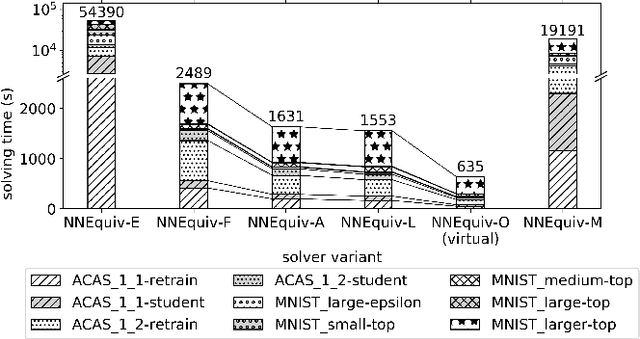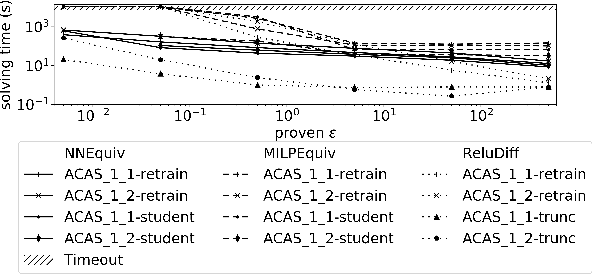Philipp Kern
Revisiting Differential Verification: Equivalence Verification with Confidence
Oct 26, 2024Abstract:When validated neural networks (NNs) are pruned (and retrained) before deployment, it is desirable to prove that the new NN behaves equivalently to the (original) reference NN. To this end, our paper revisits the idea of differential verification which performs reasoning on differences between NNs: On the one hand, our paper proposes a novel abstract domain for differential verification admitting more efficient reasoning about equivalence. On the other hand, we investigate empirically and theoretically which equivalence properties are (not) efficiently solved using differential reasoning. Based on the gained insights, and following a recent line of work on confidence-based verification, we propose a novel equivalence property that is amenable to Differential Verification while providing guarantees for large parts of the input space instead of small-scale guarantees constructed w.r.t. predetermined input points. We implement our approach in a new tool called VeryDiff and perform an extensive evaluation on numerous old and new benchmark families, including new pruned NNs for particle jet classification in the context of CERN's LHC where we observe median speedups >300x over the State-of-the-Art verifier alpha,beta-CROWN.
Optimized Symbolic Interval Propagation for Neural Network Verification
Dec 15, 2022Abstract:Neural networks are increasingly applied in safety critical domains, their verification thus is gaining importance. A large class of recent algorithms for proving input-output relations of feed-forward neural networks are based on linear relaxations and symbolic interval propagation. However, due to variable dependencies, the approximations deteriorate with increasing depth of the network. In this paper we present DPNeurifyFV, a novel branch-and-bound solver for ReLU networks with low dimensional input-space that is based on symbolic interval propagation with fresh variables and input-splitting. A new heuristic for choosing the fresh variables allows to ameliorate the dependency problem, while our novel splitting heuristic, in combination with several other improvements, speeds up the branch-and-bound procedure. We evaluate our approach on the airborne collision avoidance networks ACAS Xu and demonstrate runtime improvements compared to state-of-the-art tools.
Geometric Path Enumeration for Equivalence Verification of Neural Networks
Dec 13, 2021



Abstract:As neural networks (NNs) are increasingly introduced into safety-critical domains, there is a growing need to formally verify NNs before deployment. In this work we focus on the formal verification problem of NN equivalence which aims to prove that two NNs (e.g. an original and a compressed version) show equivalent behavior. Two approaches have been proposed for this problem: Mixed integer linear programming and interval propagation. While the first approach lacks scalability, the latter is only suitable for structurally similar NNs with small weight changes. The contribution of our paper has four parts. First, we show a theoretical result by proving that the epsilon-equivalence problem is coNP-complete. Secondly, we extend Tran et al.'s single NN geometric path enumeration algorithm to a setting with multiple NNs. In a third step, we implement the extended algorithm for equivalence verification and evaluate optimizations necessary for its practical use. Finally, we perform a comparative evaluation showing use-cases where our approach outperforms the previous state of the art, both, for equivalence verification as well as for counter-example finding.
* Paper presented at The 33rd IEEE International Conference on Tools with Artificial Intelligence (ICTAI)
 Add to Chrome
Add to Chrome Add to Firefox
Add to Firefox Add to Edge
Add to Edge